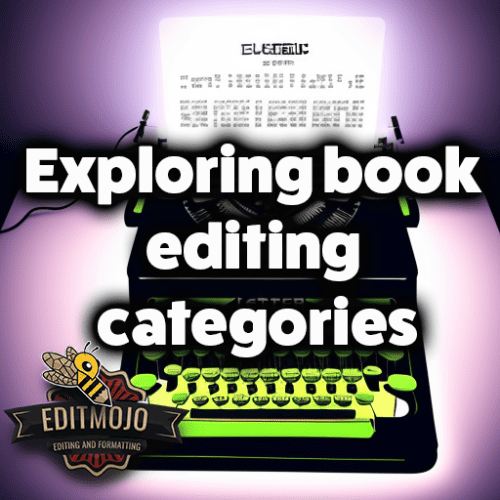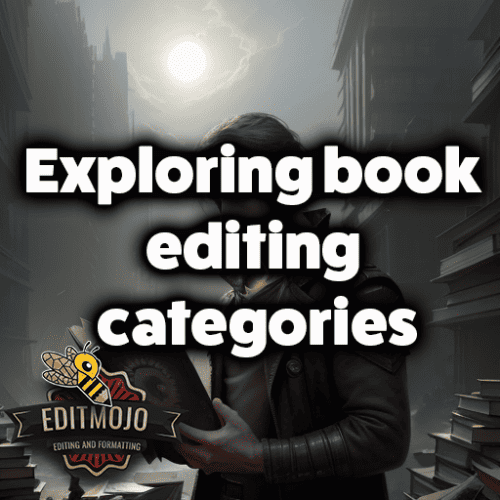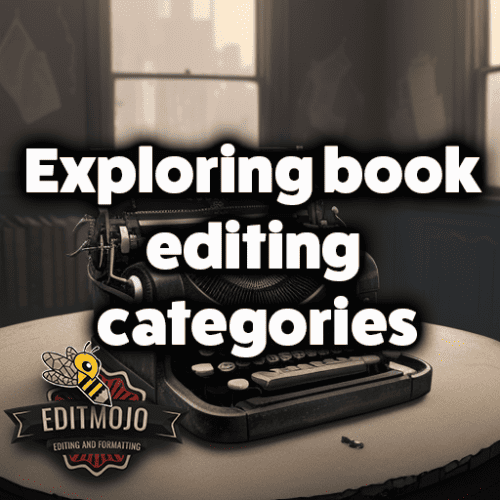Exploring book editing categories
Exploring book editing categories. The art of creating a masterpiece isn’t solely about the initial draft; the magic often lies in the meticulous process of editing. As a vital part of writing, book editing deserves its due diligence. An understanding of its diverse categories, from structural changes to final proofreading, is crucial for both authors and editors. It’s akin to crafting a diamond; each stage of cutting, shaping, and polishing transforms a rough stone into a dazzling gem. So, let’s embark on a journey to explore these stages of transformation in the realm of book editing.
Key Takeaway Table
| Stages of Book Editing | Key Takeaways |
|---|---|
| Developmental Editing | It’s the first stage of editing, focused on shaping the structure of the manuscript, including aspects like plot, character development, pacing, and voice. |
| Substantive Editing | This stage ensures the story’s consistency and clarity, often involving rephrasing sentences, deleting or adding text, and addressing inconsistencies. |
| Copy Editing | Copy editing checks grammar, punctuation, spelling, and style in the manuscript, using style guides to ensure consistency and correctness. |
| Line Editing | At this stage, each line is refined for maximum impact, with a focus on sentence rhythm, variety, and word choice. |
| Proofreading | The final stage of editing, proofreading, catches last-minute errors, including typos, extra spaces, or missed punctuation marks. |
| Collaboration | Editors and authors should work collaboratively, respecting each other’s vision and feedback. |
| Choosing the Right Editor | Factors like experience, testimonials, and genre expertise should be considered when hiring an editor. |
| The Future of Book Editing | Technology is changing the landscape of book editing, with developments like AI editors and collaborative online platforms. |
The Editing Spectrum: An Overview
Consider the editing process as a spectrum—each stage contributing towards honing your manuscript to perfection. Starting from developmental editing, progressing through substantive editing, copy editing, line editing, and finally culminating in proofreading, the editing spectrum ensures your work is polished, presentable, and positively engaging.
Developmental Editing: Making Structural Changes
The first stage, developmental editing, is like the architect’s blueprint for a building. A developmental editor is responsible for shaping the structure of your manuscript, working closely with the author to align the narrative with the envisioned story.
This stage dives deep into elements like plot structuring, character development, pacing, and voice. A developmental editor might suggest significant changes, like reordering chapters or deepening character arcs, to enhance the story’s overall flow and impact.
Let’s take an example from the world of bestsellers. J.K. Rowling’s “Harry Potter and the Order of Phoenix”, initially had Arthur Weasley’s character dying. But in the editing process, Rowling and her editor decided that his survival added a depth to the narrative, making it more compelling.

Substantive Editing: Ensuring Consistency and Clarity
Once the structure is in place, we enter the realm of substantive editing. This stage ensures your story is consistent, clear, and engaging. It’s like a decorator coming into a newly built house to ensure each room has the right aesthetic, ambiance, and coherence.
A substantive editor scrutinizes your manuscript for elements like clarity, coherence, tone, and style. This process often involves rephrasing sentences, deleting or adding text, and addressing any potential inconsistencies.
A glimpse of substantive editing in action can be seen in F. Scott Fitzgerald’s “The Great Gatsby.” His editor, Max Perkins, was instrumental in refining the manuscript, cutting unnecessary portions, and ensuring the final version remained a classic in American literature.
Copy Editing: Checking Grammar, Spelling, and Syntax
Once the manuscript is well-structured and coherent, we enter the meticulous world of copy editing. This stage checks your manuscript’s grammar, punctuation, spelling, and style. Think of a copy editor as a quality control inspector, checking every nook and cranny of a product before it’s ready for the market.
Copy editors work with style guides, like the AP Stylebook or the Chicago Manual of Style, to ensure consistency and correctness. Common errors often involve misplaced commas, incorrect usage of semi-colons, or overuse of passive voice. Remember, even the best writers aren’t immune to these small mistakes, and that’s where the vigilant eyes of copy editors come in.
Line Editing: Refining Each Line for Maximum Impact
Next, we have line editing, a stage focused on refining each line of your manuscript to ensure maximum impact on the reader. It’s like a music producer fine-tuning each note to make the song resonate with listeners.
During line editing, each sentence is examined for its rhythm, variety, and word choice. A line editor might rephrase a line to improve its punch or change the order of sentences to enhance the narrative flow.
An excellent example of line editing can be found in Ernest Hemingway’s work. His line editor, Maxwell Perkins, was known for influencing Hemingway’s terse, minimalistic style, shaping the distinctive voice we recognize today.
Proofreading: The Final Polish
Finally, we arrive at proofreading, the last and final stage before the manuscript is ready for the world to see. It’s like a car wash and polish just before a new vehicle is displayed in the showroom.
Proofreading catches last-minute errors such as typos, extra spaces, or missed punctuation marks. Despite advancements in spell checkers and grammar tools, nothing can yet replace the eagle eye of a professional proofreader.
Consider the infamous example of an edition of the Bible known as the “Wicked Bible” printed in 1631. A proofreading error left the word “not” out of the seventh commandment, which then read “Thou shalt commit adultery.” This costly mistake underscores the significance of thorough proofreading.

Collaboration Between Editors and Authors
At all these stages, it’s important for editors and authors to work in tandem, respecting each other’s vision and feedback. The editing process is a collaboration, not a competition. As an author, be open to criticism, and as an editor, always strive to maintain the author’s unique voice and vision.
Choosing the Right Editor for Your Manuscript
Choosing the right editor is like finding the perfect dance partner. You need someone who understands your rhythm, style, and the story you want to tell. Consider factors like experience, testimonials, and genre expertise when hiring an editor. Platforms like Reedsy can connect you with professional editors who can turn your manuscript into a masterpiece.
The Future of Book Editing
As technology advances, the landscape of book editing is evolving. AI editors and collaborative online platforms are gaining popularity. However, the human touch in understanding nuance and context remains irreplaceable. It’s a brave new world of opportunities and challenges, promising exciting developments for authors and editors alike.
Conclusion
Each stage of book editing is a critical step towards creating a polished, engaging, and successful book. It’s a process that requires expertise, patience, and a deep love for storytelling. As we continue to evolve with technology, let’s remember that at the heart of editing is the story—an encapsulation of the human experience. After all, a well-edited book isn’t just a pleasure to read; it’s a journey that leaves a lasting impact on the reader’s mind and heart.

References and Further Reading
For those who wish to dive deeper into the art of book editing, I recommend the following resources:
- “The Subversive Copy Editor” by Carol Fisher Saller
- “The Artful Edit” by Susan Bell
- “Self-Editing for Fiction Writers” by Renni Browne and Dave King
Whether you’re an aspiring author or a seasoned editor, remember that each word, each sentence, and each page matters. Every story deserves to shine in the best light, and that’s precisely the magic of book editing.
Top Five Questions and Answers Table
| Questions | Answers |
|---|---|
| What is the difference between substantive editing and copy editing? | Substantive editing focuses on the content, style, and flow of the manuscript, ensuring clarity and coherence. Copy editing, on the other hand, involves checking grammar, punctuation, spelling, and style for consistency and correctness. |
| What is the importance of proofreading even in the era of advanced spell checkers and grammar tools? | While automated tools can catch many errors, they can’t yet match the nuanced understanding of language that a human proofreader has. Proofreaders can catch context-specific errors and subtle nuances that automated tools might miss. |
| How can an author choose the right editor for their manuscript? | Authors should consider factors like the editor’s experience, testimonials, and genre expertise. It’s also helpful to find someone who understands their style and the story they want to tell. |
| How is technology influencing the future of book editing? | Technological advancements are introducing tools like AI editors and collaborative online platforms. These can speed up the editing process and make collaboration easier, but they also pose challenges, like ensuring the nuance and context understood by human editors. |
| Why is developmental editing important? | Developmental editing shapes the manuscript at a high level. It’s like the architect’s blueprint for a building. A developmental editor works with the author on aspects like plot structuring, character development, pacing, and voice, which are crucial to the story’s overall impact. |
Top Ten Resources and Further Reading Table
| Resources | Description |
|---|---|
| “The Subversive Copy Editor” by Carol Fisher Saller | A must-read for anyone interested in the nuts and bolts of editing. |
| “The Artful Edit” by Susan Bell | Provides valuable insights on the art of self-editing. |
| “Self-Editing for Fiction Writers” by Renni Browne and Dave King | An excellent guide for fiction writers who want to self-edit. |
| “Revision and Self-Editing for Publication” by James Scott Bell | Useful tips and techniques for revising and editing a manuscript. |
| “American Society of Copy Editors” | Professional association for those in the editing profession. |
| “Grammar Girl’s Quick and Dirty Tips for Better Writing” | An engaging blog that simplifies complex grammar questions. |
| “Purdue Online Writing Lab” | A free online writing resource that covers grammar, punctuation, and style. |
| “Chicago Manual of Style” | The definitive guide to English language style and usage. |
| “Pro Writing Aid” | A helpful online editing tool that offers suggestions for improvement. |
| “The Editor’s Blog” | A blog with advice and insights from professional editors. |
Interactive Quiz: How Well Do You Know Book Editing?
- Which stage of editing involves checking for grammatical, spelling, and syntax errors?
- a. Substantive editing
- b. Developmental editing
- c. Line editing
- d. Copy editing
- Which editing stage may include significant changes to the plot, character development, and pacing of a story?
- a. Proofreading
- b. Developmental editing
- c. Copy editing
- d. Substantive editing
- Which stage of editing refines each line for maximum impact and focuses on rhythm and word choice?
- a. Line editing
- b. Copy editing
- c. Substantive editing
- d. Developmental editing
- What is the final stage of the editing process?
- a. Copy editing
- b. Line editing
- c. Proofreading
- d. Substantive editing
- What crucial skill does a human proofreader have that automated tools can’t match?
- a. Faster error detection
- b. Understanding of language nuance and context
- c. Knowledge of grammar rules
- d. Ability to work round-the-clock
Quiz Answers: 1. d, 2. b, 3. a, 4. c, 5. b
